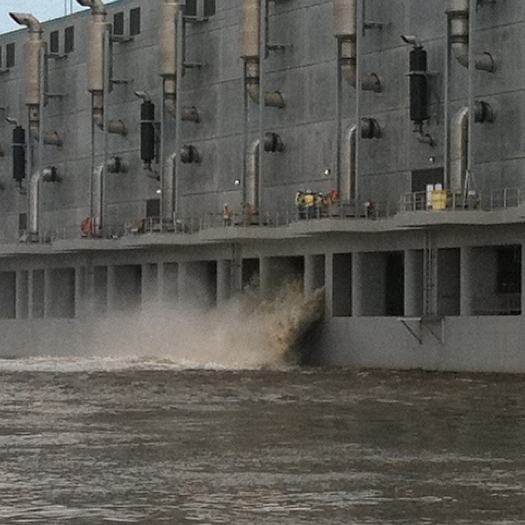
[“On Tuesday, May 24, pump number eight at the West Closure Complex was successfully tested. There are a total of 11 pumps at the [Complex], and each can individually fill an olympic-sized swimming pool in less than a minute.” (Source.)]

[While most of the Mississippi River flood control infrastructures that we have looked at have been intended to protect land downstream from floodwaters originating upstream, the Louisiana delta is, of course, just as vulnerable to water moving in from the Gulf, and the devastation produced by Katrina has spurred a large infrastructural building program aimed at replacing and upgrading the defenses that proved so inadequate in that storm. (The Intracoastal Waterway provides a point of particular vulnerability to inward-bound waters.) The West Closure Complex, a massive infrastructural agglomeration composed of “a navigable floodgate, a pumping station, floodwalls, sluice gates, foreshore protection, and an earthen levee” is one of those protective works. (The site of the Complex — then under construction — can be seen in the satellite image above.)
In 2009, as construction on the Complex began, Popular Mechanics ran a piece explaining how the Complex functions: “first, operators will shut the 32-foot-tall, 225-foot-wide metal gates to block the surge [and] then they’ll fire up the world’s largest pumping station, which pulls 150,000 gallons of floodwater per second.”
That’s instrumentality.
For more on the Complex, watch the Army Corp’s explanatory video here.]


What I’ve found particularly interesting about this series of posts is that it reveals the tremendous amount of effort (and physical infrastructure) required to maintain a stable terrain within the Louisiana delta at the same time as it explores the infrastructures of trade, transit, and agricultures that depend upon this stability.
I say “interesting” because the rigidity we demand of geology, in this context, starkly contrasts with the geographic instability and flexibility generated by modern capitalist economies. But the trade movements that can rapidly erode the economic fortunes of any individual town, city, or state aren’t actually possible without a fixed set of infrastructure. And so the sediment isn’t allowed to take its natural course…
That’s an excellent point. I’d been thinking about each of those things in isolation, but hadn’t noted the contrast between them.
The decay cycles of logistical infrastructures (ports, shipping channels, distribution centers, etc.) are of great interest to me at the moment, as I’ve been thinking a lot (with Stephen and others) about the spatial expressions of post-Fordist capitalism, grouped around a couple of key questions:
– Where are the most significant material instantiations of globalization? How do they behave? (Posts on Aerotropolis and iPhone landscapes were particularly related to this, though it also ties into the flood series.)
– What comes next? (Re-industrialization? Materials are increasingly cycled continuously, rather than used and discarded?)
– Where is landscape-making agency located? (This is something of a parochial disciplinary concern, but I’m interested in the idea that landscape architecture (as it is presently constituted) is a light-weight actor, while trade patterns and material cycles are heavyweights. This implies a potential re-organization of landscape architecture, and the landscape architects I’m most interested by — Waldheim, Berger, Belanger — have been thinking about this for a quite a while now.)
Glad it’s a useful point! I don’t have any systematic responses to the questions you raise, unfortunately.
I think looking at space through the lens of time is a useful approach – decay cycles and turnover time of capital are key determinants of the relative fixity of any given part of the production and distribution system.
A few years back, I did some statistical modeling work for a piece of energy infrastructure in the Louisiana delta – a liquefied natural gas receiving terminal. The company building the thing had a quite long planning horizon – they were looking to lock in 20- or 30-year supply contracts. They would require a quite long period of relative geologic stability to recoup the investment. Other organizations – public or private – would obviously be planning for much different time horizons. I suspect that resource-based infrastructures would have a much longer time horizon on average than, say, infrastructures connected with labor-intensive manufacturing or retail.
It’s been a couple of years since I’ve read it, but David Harvey’s Limits to Capital discusses these issues in a more general fashion. I’ve gotten a lot out of that book.
Hard to comment on the agency of landscape architecture – there’s always the potential to subvert or modify existing economic patterns, but to what degree?
Amazing write-up nevertheless I used to be wondering in case you could publish a litte read more about that matter? I’d be quite grateful if you can sophisticated a bit further. Thanks!